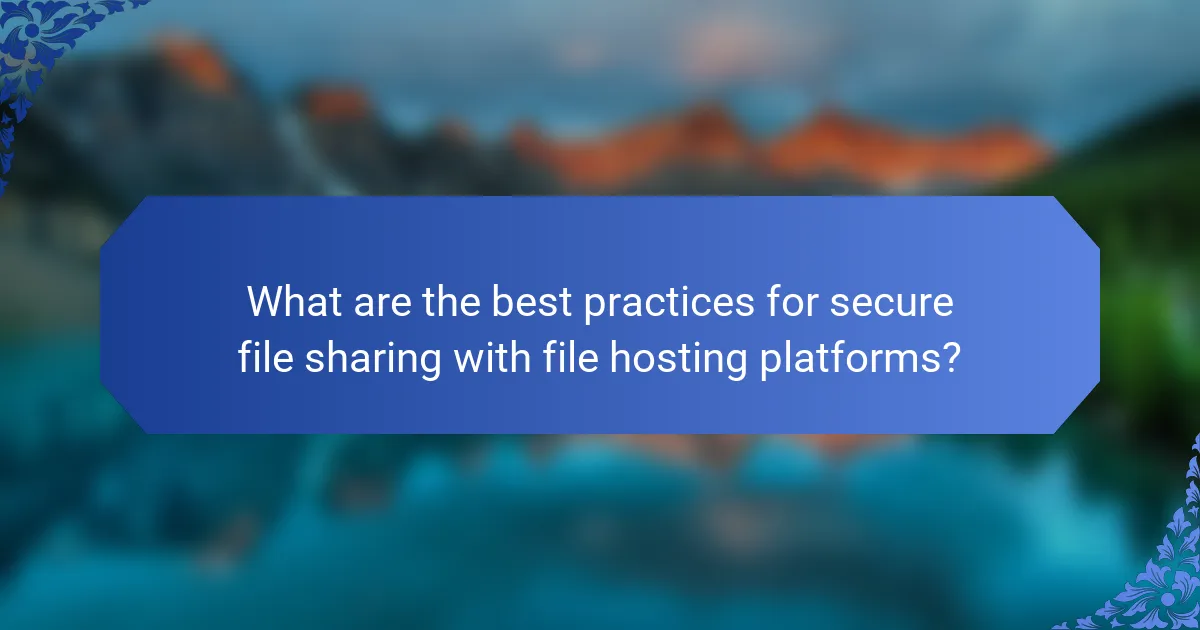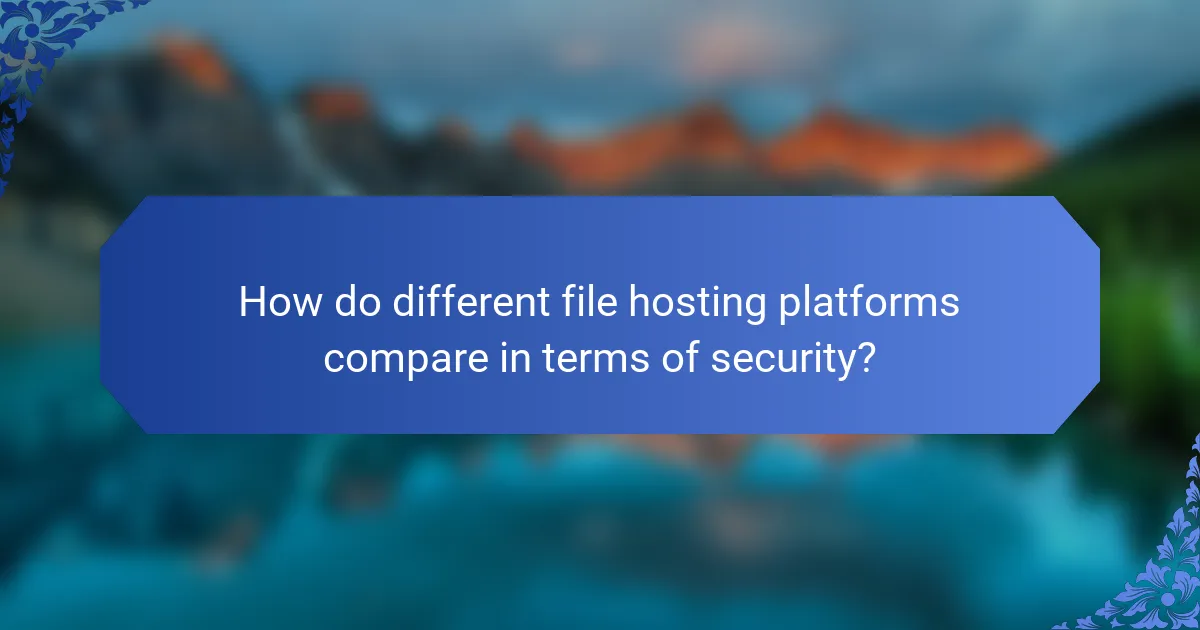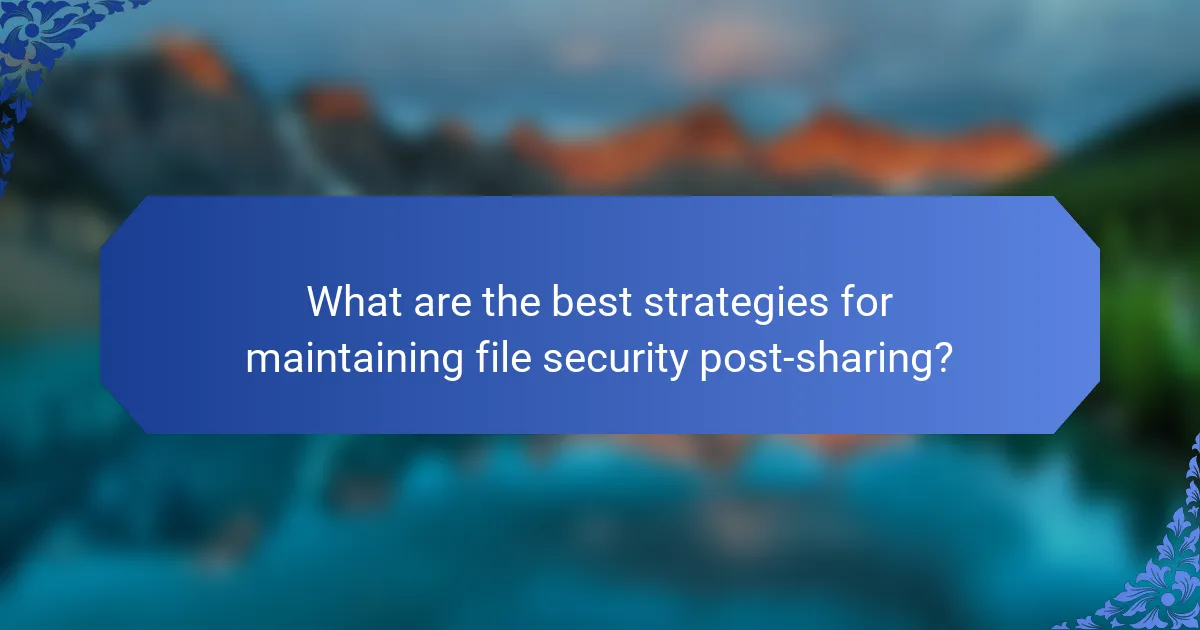Secure file sharing is essential for protecting sensitive data from unauthorized access. This article outlines best practices for using file hosting platforms, emphasizing the importance of strong encryption, two-factor authentication, and secure link sharing. It highlights the significance of choosing reputable platforms that comply with industry standards like GDPR and HIPAA, as well as the need for regular access permission reviews and user education on security risks. Additionally, it discusses key security features of various platforms, such as Google Drive, Dropbox, OneDrive, and Tresorit, and offers strategies to enhance file security both before and after sharing.

What are the best practices for secure file sharing with file hosting platforms?
Use strong encryption for files before sharing. Encryption protects data from unauthorized access. Choose a reputable file hosting platform with robust security measures. Platforms should comply with industry standards like GDPR or HIPAA. Implement two-factor authentication for added security. This adds an extra layer of verification. Share files through secure links rather than attachments. Secure links reduce the risk of interception. Regularly review and manage access permissions. This ensures only authorized users have access. Educate users on phishing and social engineering risks. Awareness helps prevent unauthorized access to shared files.
How can users ensure their files are secure during sharing?
Users can ensure their files are secure during sharing by utilizing encryption. Encryption converts files into a coded format that only authorized users can access. This protects sensitive information from unauthorized access. Additionally, users should employ secure file sharing platforms that offer built-in security features. These features may include password protection and access controls. Regularly updating passwords and using unique passwords for different accounts enhances security. Users should also avoid sharing sensitive files over unsecured networks. According to a 2020 study by the Ponemon Institute, 60% of organizations experienced a data breach due to unsecured file sharing practices.
What encryption methods should be used for secure file sharing?
AES (Advanced Encryption Standard) is the recommended encryption method for secure file sharing. AES provides strong security through symmetric key encryption. It supports key sizes of 128, 192, and 256 bits. The use of 256-bit keys offers the highest level of security. RSA (Rivest-Shamir-Adleman) is also commonly used for secure file sharing. RSA employs asymmetric encryption, using a public and private key pair. This method is effective for securely transmitting encryption keys. End-to-end encryption (E2EE) is crucial for protecting files during transfer. E2EE ensures that only the sender and recipient can access the content. Many file hosting platforms implement these encryption methods to enhance security. These methods are widely recognized and validated by security experts.
How does two-factor authentication enhance file sharing security?
Two-factor authentication enhances file sharing security by requiring two forms of verification before access is granted. This process significantly reduces the risk of unauthorized access. Users must provide something they know, like a password, and something they have, such as a mobile device for a verification code. According to a report by the Cybersecurity & Infrastructure Security Agency, two-factor authentication can block 99.9% of automated attacks. This dual-layered approach ensures that even if a password is compromised, access remains protected. Implementing two-factor authentication is a crucial step in safeguarding sensitive files during sharing. It adds a critical barrier against potential breaches in file hosting platforms.
What are the common risks associated with file sharing on hosting platforms?
Common risks associated with file sharing on hosting platforms include data breaches, malware infections, and unauthorized access. Data breaches can occur when sensitive information is exposed due to inadequate security measures. Malware infections happen when users download infected files, compromising their devices. Unauthorized access can result from weak passwords or improper sharing settings, allowing unintended users to view or edit files. According to a 2021 report by Verizon, 85% of data breaches involve human factors, highlighting the importance of secure practices in file sharing.
How can malware impact shared files and users?
Malware can significantly compromise shared files and users by corrupting data and stealing sensitive information. It can infiltrate file hosting platforms, leading to unauthorized access to shared documents. Once malware infects a system, it may encrypt files, making them inaccessible to legitimate users. Additionally, malware can spread to other connected devices, further jeopardizing data integrity. It may also log keystrokes or capture personal information, exposing users to identity theft. According to a report by Cybersecurity Ventures, cybercrime damages are projected to reach $10.5 trillion annually by 2025, highlighting the severe risks posed by malware.
What are the implications of data breaches in file hosting services?
Data breaches in file hosting services can lead to significant security and privacy implications. Unauthorized access to sensitive files can result in identity theft, data loss, and reputational damage for both individuals and organizations. According to the Identity Theft Resource Center, there were over 1,100 data breaches reported in 2020 alone. This statistic highlights the prevalence of such incidents.
Furthermore, breaches can lead to legal consequences. Organizations may face lawsuits if they fail to protect user data adequately. Compliance with regulations like GDPR or HIPAA can also be compromised, leading to hefty fines.
In addition, users may lose trust in file hosting services after a breach. A survey by Ponemon Institute found that 71% of consumers would stop using a service after a data breach. This loss of trust can have long-term financial impacts on the service provider.
Overall, the implications of data breaches in file hosting services extend beyond immediate security concerns. They encompass legal, financial, and reputational risks that can affect all stakeholders involved.

How do different file hosting platforms compare in terms of security?
Different file hosting platforms vary significantly in terms of security. Key security features include encryption, access controls, and data redundancy. For instance, Google Drive uses encryption in transit and at rest, ensuring data protection. Dropbox offers two-factor authentication and file recovery options, enhancing user security. OneDrive provides advanced threat detection and compliance with industry standards. Box focuses on enterprise-level security with customizable access permissions. Research indicates that platforms with end-to-end encryption, like Tresorit, offer superior security against unauthorized access. Each platform’s reputation for security can be assessed through user reviews and third-party security audits.
What security features should users look for in file hosting platforms?
Users should look for encryption, both in transit and at rest, in file hosting platforms. Encryption protects data from unauthorized access during transfer and while stored. Additionally, users should seek platforms with two-factor authentication (2FA). 2FA adds an extra layer of security beyond just a password.
Another important feature is access control. This allows users to set permissions for who can view or edit files. Regular security audits by the platform can also indicate a commitment to maintaining security standards.
Data redundancy is crucial as well. It ensures that files are backed up in multiple locations to prevent data loss. Finally, compliance with data protection regulations, such as GDPR, is essential. This shows that the platform adheres to established security and privacy standards.
How do user reviews reflect the security of different platforms?
User reviews reflect the security of different platforms by highlighting user experiences with data protection. Reviews often mention specific security features, such as encryption and two-factor authentication. Positive reviews may indicate that users feel safe sharing sensitive information. Conversely, negative reviews can reveal security breaches or vulnerabilities. Users frequently discuss how responsive a platform is to security concerns. A platform with many complaints about security may be perceived as less trustworthy. Additionally, reviews can provide insights into the effectiveness of a platform’s security measures. Overall, user feedback serves as a valuable indicator of a platform’s security reputation.
Which platforms are recognized for their strong security measures?
Platforms recognized for their strong security measures include Dropbox, Google Drive, and Microsoft OneDrive. Dropbox employs advanced encryption and two-factor authentication. Google Drive uses encryption in transit and at rest. Microsoft OneDrive integrates with Microsoft 365 security features, providing robust protection. These platforms consistently rank high in security assessments. They adhere to industry standards, ensuring user data remains safe.
What role do user permissions play in secure file sharing?
User permissions are critical in secure file sharing as they control access to sensitive information. By defining who can view, edit, or share files, organizations can minimize the risk of unauthorized access. Properly configured user permissions help ensure that only authorized individuals can interact with specific files. This reduces the likelihood of data breaches and information leaks. According to a study by the Ponemon Institute, 63% of data breaches result from human error, highlighting the importance of managing user permissions effectively. Effective permission management also allows for audit trails, enabling organizations to track who accessed or modified files. This accountability further enhances security measures in file sharing practices.
How can setting permissions prevent unauthorized access?
Setting permissions can prevent unauthorized access by controlling who can view or edit files. Permissions define user roles and access levels for specific documents or folders. For example, only designated users may have editing rights, while others have view-only access. This limits the potential for unauthorized changes or data breaches. Additionally, permissions can be adjusted based on user needs, enhancing security further. Organizations often implement role-based access control to ensure only relevant personnel have access. According to the National Institute of Standards and Technology, effective access control is essential for protecting sensitive information.
What are the best practices for managing shared links?
Best practices for managing shared links include using password protection, setting expiration dates, and limiting access permissions. Password protection ensures that only authorized users can access the shared content. Setting expiration dates prevents long-term access, enhancing security. Limiting access permissions restricts users to view-only or edit capabilities, reducing the risk of unwanted changes. Regularly reviewing shared links helps identify and remove outdated or unnecessary access. Additionally, using link tracking tools provides insights into who accessed the links and when. These practices collectively enhance the security and management of shared links, ensuring sensitive information remains protected.

What are the best strategies for maintaining file security post-sharing?
Use encryption to protect files after sharing. Encryption ensures that only authorized users can access the content. Implement password protection for shared files to add an extra layer of security. Regularly update access permissions to control who can view or edit the files. Monitor file access logs to detect any unauthorized attempts. Utilize secure file hosting platforms that offer built-in security features. Educate users about best practices for file security to reduce human error. Regularly back up files to prevent data loss in case of security breaches. These strategies collectively enhance file security post-sharing.
How can users monitor shared files after distribution?
Users can monitor shared files after distribution through various tools and practices. File hosting platforms often provide tracking features. These features allow users to see who accessed the files. Users can also receive notifications for file downloads or edits. Some platforms offer version control to track changes. Analytics tools can provide insights on file engagement. Users can set permissions to restrict access. Regular audits of shared files can enhance security.
What tools are available for tracking file access and changes?
Tools available for tracking file access and changes include file auditing software, version control systems, and activity monitoring tools. File auditing software, such as SolarWinds or ManageEngine, tracks user access and modifications to files. Version control systems like Git and Subversion enable tracking of changes in file versions over time. Activity monitoring tools, including Splunk and Loggly, provide insights into file access patterns and changes. These tools help organizations ensure compliance and maintain security by providing detailed logs of file interactions.
How can users revoke access to shared files effectively?
Users can revoke access to shared files by adjusting sharing settings on the file hosting platform. Most platforms allow users to manage access permissions through their interface. Users should locate the specific file or folder they wish to modify. Then, they can select the option to manage sharing or permissions. Users can remove individuals or groups from the access list. In some cases, users can set expiration dates for access. This ensures that access is temporary and automatically revoked after a specified period. Many platforms also provide notifications to confirm that access has been revoked. Following these steps helps maintain file security and control over shared information.
What tips can enhance secure file sharing practices?
Use strong encryption for files during transfer and storage. Encryption protects sensitive data from unauthorized access. Implement access controls to limit who can view or edit shared files. This reduces the risk of data breaches. Regularly update software and file-sharing platforms to patch vulnerabilities. Keeping systems updated ensures protection against known threats. Use secure passwords and enable two-factor authentication for accounts. This adds an extra layer of security. Educate users on phishing attacks and secure sharing practices. Awareness can prevent accidental data leaks. Monitor file-sharing activity for unusual behavior. This helps detect potential security incidents early.
How can regular updates improve file sharing security?
Regular updates enhance file sharing security by patching vulnerabilities. Software developers frequently release updates to fix security flaws. These flaws can be exploited by cybercriminals to gain unauthorized access. Regular updates ensure that the latest security measures are in place. This reduces the risk of data breaches and unauthorized file access. For example, a 2021 report by Cybersecurity Ventures indicated that 60% of data breaches involved unpatched vulnerabilities. Therefore, keeping software updated is crucial for maintaining a secure file sharing environment.
What are the most effective ways to educate users on file security?
The most effective ways to educate users on file security include regular training sessions, clear policies, and practical exercises. Training sessions should cover topics like password management and phishing awareness. Clear policies should outline acceptable file sharing practices and consequences for violations. Practical exercises, such as simulated phishing attacks, reinforce learning. Visual aids like infographics can enhance understanding. Regular updates on emerging threats keep users informed. Engaging users through interactive workshops fosters a proactive security culture. Research shows that organizations with regular training see a significant decrease in security incidents. According to the 2021 Cybersecurity Workforce Study, companies with security awareness programs reduce risk by up to 70%.
Best practices for secure file sharing with file hosting platforms focus on protecting sensitive information through various security measures. Key strategies include using strong encryption methods like AES and RSA, implementing two-factor authentication, and selecting reputable platforms that comply with industry standards. Users are advised to manage access permissions diligently, educate themselves on security risks, and regularly monitor shared files to prevent unauthorized access. The article also highlights the importance of understanding the implications of data breaches and the role of user permissions in maintaining file security.
